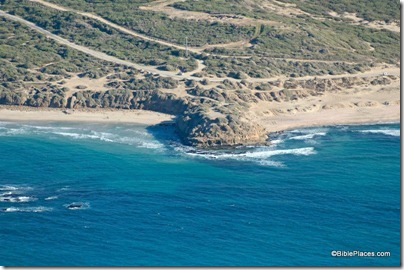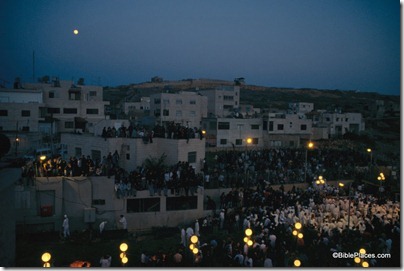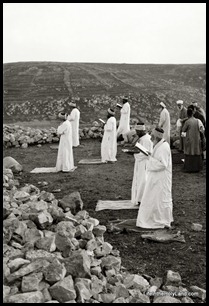A 600-lb metal anchor from the Byzantine period has been discovered off the coast south of Tel Aviv. The find led investigators to two others in the area. Photos are available from the IAA in a zip file. The Sound the Shofar exhibition opened last week in Jerusalem with more than 140 of the horns on display at the Bible Lands Museum. The story includes a two-minute video. The Jerusalem Post has more information about Google Street View in Jerusalem, Tel Aviv, and Haifa. Wayne Stiles takes readers on a visit to Shiloh, the longtime home of the tabernacle. The Archaeology of Libya is discussed in this week’s radio program at the Book and the Spade. (Here’s the direct link to the mp3 file). ATS Pro Terra Sancta has plans to renovate “the Holy Place of Sebastia.” I certainly support improving the conditions at the ancient city of Samaria, though it strikes me as odd to consider as holy the place where Ahab built a temple for Baal worship and Herod built another for the worship of the Roman emperor. An inscription in Aramaic and Greek on a stone lintel has been discovered in the area of ancient Sepphoris. The report is in Hebrew and includes a photograph. A Roman-era style bathhouse was constructed in the middle of a Early Islamic period fortress, say archaeologists excavating at Yavneh-Yam on Israel’s coast. HT: Joseph Lauer, Jack Sasson  Yavneh-Yam
Yavneh-Yam
From FoxNews.com:
Working on an urban lot that long served residents of Nablus as an unofficial dump for garbage and old car parts, Dutch and Palestinian archaeologists are learning more about the ancient city of Shekhem — and preparing to open the site to the public as an archaeological park next year. The project, carried out under the auspices of the Palestinian Department of Antiquities, also aims to introduce the Palestinians of Nablus, who have been beset for much of the past decade by bloodshed and isolation, to the wealth of antiquities in the middle of their city. "The local population has started very well to understand the value of the site, not only the historical value, but also the value for their own identity," said Gerrit van der Kooij of Leiden University in the Netherlands, who co-directs the dig team. "The local people have to feel responsible for the archaeological heritage in their neighborhood," he said. The digging season wrapped up this week at the site, known locally as Tel Balata.
The full story is here. I’m less optimistic than the archaeologists that the local people will care for the archaeological heritage or take the steps necessary to encourage tourism.
- Tagged Excavations, Samaria
With the absence of Bryant Wood from this year’s excavation, Gary Byers directed the team working at Khirbet el-Maqatir, a site proposed to be biblical Ai of Joshua’s time. Byers has summarized the findings of the season:
This year’s focus was three different time periods in three different parts of the site. 1.) The 4th-6th century AD Byzantine monastery on the rise to the northwest 2.) The 2nd century BC through 2nd century AD Hellenistic/Roman settlement on the low rise to the northeast 3.) Our major focus and the reason for choosing Khirbet el-Maqatir in the first place, the 15th century BC fortress of Ai from Joshua’s time in the saddle between these other two sets of ruins To our disappointment, three squares which we hoped would identify remains of city walls or interior structures from Joshua’s time went to bedrock without finding any architecture of significance. But in the other nine squares, we found interesting material related to our other two focus periods. Unfortunately, for the first time since we began excavating at Khirbet el-Maqatir, Dr. Bryant Wood was not in the field with us. He was home recouping from a recent stem cell transplant procedure and chemotherapy. His health continues to improve and his spirits are good. (Please continue to lift him up in prayer). But this year he is getting his information from square supervisor reports and analysis, back home, of the objects and pottery we found. This writer was with Dr. Wood when he first stepped on the site in 1994, and has participated with him in every dig season since. Consequently, it was my responsibility to lead the team in his absence. Every digger understood the situation and did their part to make things run smoothly. Of course, without Dr. Wood, it didn’t (!), but excavation results were still quite meaningful – no doubt empowered by the prayer support of folks back home. Our major interest in Khirbet el-Maqatir is the fortress of Ai from Joshua’s time. That period is also my special area of interest, so no one was any more disappointed than I when we did not find any architecture associated with Joshua’s Ai. I have been known to suggest that the Hasmonean, Roman and Byzantine periods are just modern history and not that interesting! But this year’s finds from these periods actually turned out to be pretty interesting, even to me.
The report continues with descriptions of the discoveries related to the Byzantine church, the Hellenistic-Roman settlement, and the 15th century BC fortress.
- Tagged Excavations, Samaria
Years of relative quiet in the West Bank have led to increasingly large crowds of Israelis and foreigners attending the Samaritan Passover ceremony. Not all of the Samaritans are happy about the intruders. From Haaretz:
The real problem was the area around the altar on which the sacrifice was to be made, which was surrounded by a fence and designated for prominent Samaritan community members, who surrounded it to fend off visitors. One young woman from Jerusalem spied an elderly Samaritan woman who was having difficulty walking, took her hand, and accompanied her to the site; for her pains, she remained inside the altar area until the end of the evening, taking photos of the slaughtered lambs with her cell phone. Other Israelis passed themselves off as journalists, invited guests, army officers – anything to get closer.
Asher, a red-haired Samaritan from Holon, despaired. “Who needs this headache, go home,” he growled, frustrated by the dozens of people blocking his path. “But we are your guests,” somebody insisted. “You’re not my guests, go home,” he responded.
Another Samaritan proposed charging visitors an entry fee next year. One elder confessed that his community had lost control of the annual ritual. The mountaintop site is not suited to thousands of visitors, he said, and there is not enough space for photographers. Meanwhile, some young people climbed atop a Palestinian fire truck nearby; others watched from the rooftop of a building, which did not appear to be strong enough to bear them; the barbed-wire surrounding the building did not deter anyone. Other visitors knocked on doors of private houses and asked to watch the ceremony inside.
Almost everyone had sophisticated camera equipment. One photographer who tried to barge her way into the closed-off altar area complained that she just had to take pictures. Said one Samaritan guard nearby: “It’s all on YouTube.”
I’ve seen similar attitudes with Samaritans as with Israelis, Palestinians, Egyptians, and others.
When times are hard and visitors are few, they gladly welcome outsiders. Tourists who want a VIP welcome right now are advised to head to Egypt.
This year the celebration was held on Sunday evening, the day before the Jewish Passover. For more reading about the event, I recommend the top hits given on Google search. In addition, see this page for views and perspectives before tourists outnumbered Samaritans.
The BBC has a brief profile of the modern Samaritans and some of the challenges they face, including their uneasy position between Jews and Arabs, and their hesitance to bring outsiders into the community.
For hundreds of years, the Samaritans have been caught between warring groups.
Before, they would take sides, but now they are trying a new approach – neutrality.
They are building good relations with their Palestinian and Jewish neighbours and are unique in the region for having both Israeli and Palestinian identity papers.
This means they can travel between Israel and the West Bank with ease.
Some entrepreneurial Samaritans are now using their unique status to offer a delivery service to businessmen in the West Bank town of Nablus, just a few miles away from Mount Gerizim.
[…]
In the 1920s their numbers dropped to just over 100 and it was predicted that they would die out.
The community was struggling with birth defects because of their tradition of marrying other Samaritans, and they were not open to new converts.
But some now say that to survive, they must open up to outsiders.
[…]
More recently, an American woman has made history by becoming the first person to convert to the Samaritan faith without marrying in.
Originally from Michigan, Sharon Sullivan now lives with her four children within the Samaritan community.
The full story is here.
HT: Paleojudaica
- Tagged Samaria
The Samaritan calendar differs from the Jewish calendar, and their celebration of the Feast of Tabernacles (Sukkot) began last week. Haaretz has a brief article about the observance, along with the notice that there are 712 living Samaritans (not “about 500” or “about 600,” as I’ve always heard, but “712”).
The Samaritans, members of an ancient sect closely associated to Judaism, marked the holiday of the Tabernacles, or Sukkot, on Friday.
Followers of the religion held an annual pilgrimage ceremony on Mount Gerizim, the sect’s holiest site, near Nablus.
Though the Samaritans numbered well over one million in late Roman times, there are now only 712 remaining members, who live mostly on Mount Gerizim and in Holon.
The newspaper has a gallery of six photos, but you’ll do better to head over to the Denver Post, which has beautiful images of previous Samaritan and the Jewish celebrations. The Samaritan community also has a page with video (Hebrew) about the event. China View has even more information about the Samaritan community and Sukkot.
This photo is from the Traditional Life and Customs volume of The American Colony and Eric Matson Collection (Library of Congress, LC-matpc-01846).
HT: Joe Lauer
- Tagged American Colony Photos, Samaria
The BiblePlaces Blog provides updates and analysis of the latest in biblical archaeology, history, and geography. Unless otherwise noted, the posts are written by Todd Bolen, PhD, Professor of Biblical Studies at The Master’s University.
As an Amazon Associate we earn from qualifying purchases. In any case, we will provide honest advice.

